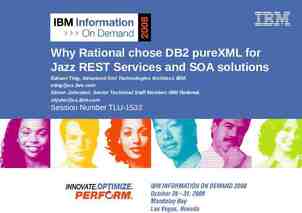Process Mapping Antonio R. Rodriguez, Director OFFICE OF QUALITY
64 Slides1.61 MB

Process Mapping Antonio R. Rodriguez, Director OFFICE OF QUALITY MANAGEMENT OFFICE OF RESEARCH SERVICES NATIONAL INSTITUTES OF HEALTH U.S. DEPARTMENT OF HEALTH AND HUMAN SERVICES

Training Objectives Become familiar with important concepts of process mapping Identify different types of process maps (PM) Describe the benefits of different PM Recognize the role of process mapping in the NIH Risk Management Program Construct a deployment flowchart Identify measurement opportunities in a process map Explain how process maps can be utilized to improve process and output performance 2

What is a process? A process is a series of steps that transform inputs to outputs – Inputs to a process include materials, methods, information, people, equipment, the work environment – Outputs of a process are products and services Everything you do in the workplace is part of a process 3

Why Is It Important to Understand Processes? 4

Why do we care about processes? Outputs (products and services) are developed using processes Understanding the underlying process is key to improving performance and the quality of outputs Inputs are outputs of previous processes Quality inputs and processes are necessary for quality outputs 5

Overview of a Process SUPPLIER INPUTS People Machinery Material Methods Information Environment PROCESS OUTPUTS CUSTOMERS OUTCOMES Products Services 6

What are process maps? Pictures of the flow or sequence of activities and decisions that result in a product or service Can be applied to any set of activities – – – – – – – Ordering slides and posters Paying invoices on time Conducting space planning Coordinating research collaboration Evacuating a building or the campus Training Responding to a protest Process maps are also known as flowcharts 7

What do process maps do? Allow a team to come to agreement on the steps needed to produce outputs Assist in examining which activities have the greatest impact on process performance Show unexpected complexity, problem areas, redundancy, unnecessary loops Identify where data can be collected and analyzed to meet a specific purpose Serve as a training aid to understand the complete process Compare the actual process against an ideal process Identify changes that may bring about improvement Adapted from Brassard & Ritter, 1994. 8

What do process maps do? (cont.) Promote understanding of the relationship of a process to a larger system or vice versa – – – – Input of materials, services, or information from suppliers Hand-offs between different work units Delivery of the output to customers Constraints set by laws, rules, regulations, or budgets Help to identify boundaries processes cross – Processes usually cut across organizational units – People rarely see, participate or understand the entire process – Process maps help people “see” the whole process 9

Types of Process Maps 10

Types of Process Maps Block Diagrams Linear Flowcharts Deployment Flowcharts 11

Block Diagrams Depict the process with the fewest details Provide a picture of high-level flow of a process Show key action steps but no decision diamonds Generally have only four or five steps Offer a “10,000 foot” view of the process 12

Example Block Diagram NIH Evacuation Emergency Happens Notify Fire Department Initiate OEP OEP – Occupant Evacuation Plan Activate Evacuation Signal Evacuate Building/ Campus 13

Basic Process Map Symbols Process Start/End Ovals mark the first step and the final step of the process Squares/rectangles represent a Process Step particular step or activity in the process Diamonds show “yes-no” decision Decision points Circles with letters or symbols specify A subroutines or connecting points; empty circles show cooperation points Arrows show the flow, or movement, of the process from one step to the next 14

Linear Flowcharts Constitute a simple form of a process map Provide an overall picture of activities required Can create a foundation for other types of flowcharts Can be completed at different levels of detail Generally have eight to perhaps twelve steps, including decisions Offer a “5,000 foot” view of the process 15

Example Linear Flowchart Campus Evacuation Process 16

Deployment Flowcharts Provide more information about processes Map what happens in a process and who is responsible for each step Communicate the interrelationships, sequence of operations, decisions required, to transform inputs into products and services Useful to: – – – – Indicate dependencies in the sequence of events Clarify roles and hand-offs Track accountability Compare workloads and identify bottlenecks within a process when used in conjunction with data 17

ORS Example Deployment Flowchart - Evacuation Process 18

Advantages of Deployment Flowcharts Processes usually extend beyond the borders of a single work unit Work groups usually only “see” the steps in their organizational unit People working on one part of the process often don’t communicate with those in other parts Deployment flowcharts are the best way to remove the mystery They provide the most amount of detail – a “100 foot” view of the process See The Memory Jogger II (Brassard & Ritter, 1994) for more information about flowcharts. 19

Utilizing Process Mapping in Support of the NIH Risk Management Program 20

NIH Risk Management Program The NIH Risk Management Program (RM Program) is an ongoing process to perform standardized repeatable activities that promote the overall efficiency, effectiveness, accountability and integrity of the organization’s work Overarching Goal is to employ proactive risk management to enhance program performance Six-phased methodology that provides a standardized means of addressing risk at NIH. NIH Risk Management Program Guidebook and other resources available at: http://oma.od.nih.gov/ 21

NIH Risk Management Approach 22

Risk Management - Terminology (pertinent to the Assess Phase) Control a mechanism to prevent or reduce the likelihood of a risk occurring, or an activity to reduce the impact of a risk should it occur. Key Control a control that management relies most heavily on to ensure a process operates correctly. Control Gap Exists when a portion of a process lacks an appropriate control Design Deficiency Exists when a control is executed as intended but does not meet the objective of mitigating a risk Operating Deficiency Exists when a properly designed control does not operate as intended, or when the person performing the control does not possess the necessary authority or qualification to perform the control effectively 23

Risk Management - Phase 3 - Assess Phase Purpose of the Assess phase is to evaluate the effectiveness of the processes and controls associated with identified risks Each Assessable Unit (AU) is responsible for conducting control assessments on risks the Risk Management Officer (RMO) selects from the AU risk inventory A control assessment evaluates the effectiveness of the processes and controls associated with an identified risk Information contained in Risk Management Program Guidebook considered best practice for conducting a control assessment 24

Risk Management - Phase 3 Assess Phase 3.1 Determine Assessment Population Identification of which risks will undergo a control assessment 3.2 Document Processes and Controls Create process flows to identify control points and associated control activities 3.3 Analyze Processes and Controls Identification of key controls, Identification of potential design deficiencies, and Determination of control gaps. 3.4 Test Controls Testing of operating effectiveness of each control * More detail can be found in the NIH Risk Management Program Guidebook 25

Risk Management - Examples (see handout) Risk Statement: If NIH does not have adequate procedures in place to ensure fire extinguishers are regularly inspected and maintained in operating condition, then a fire incident will have a greater likelihood of causing loss of life or property at NIH. 26

Risk Management - Examples (see handout) Risk Statement: If NIH does not have adequate receiving procedures in place for goods shipped from the GDC warehouse, then NIH may incur financial loses and disruptions to research activities due to lost or stolen supplies. 27

Creating A Deployment Flowchart 28

Tips for Developing Flowcharts Don’t get bogged down in too much detail or debate – Start with the big picture – Maintain a consistent level of detail (depth) throughout – Brainstorm steps and decisions and later organize in sequence There may be no ONE right process map – Processes may operate in different ways – People have different perspectives on how the process flows – Have a way to handle the differing views of team members – Document all differences and decide later the standardized approach 29

Tips for Developing Flowcharts (cont.) Keep your arrows straight – Usually a process map is easier to read if curved arrows are avoided Strive to have symbols with one arrow going in and one arrow going out – Rule doesn’t apply to decision diamonds » One arrow going in, but – » Two arrows going out One for “yes” One for “no” 30

Creating a Deployment Flowchart Step 1: Label the Process Map Step 2: Determine the Frame or Boundaries Step 3: Identify the Players in the Process Step 4: Determine the Steps in the Process Step 5: Sequence Steps/Show Responsibility Step 6: Draw the Process Map Step 7: Check the Process Map Step 8: Prepare the Process Map in Visio Step 9: Review and Revise the Process Map 31

Step 1: Label the Process Map Process mapping can be valuable at any level – Discrete Service level (output level) – Service Group level – Work unit’s activities – Individual worker’s tasks Agree on what you will be mapping Determine what level of detail you wish to capture – Identify the question of interest, problem, or opportunity pursued – Proceed to more detailed charts as needed Label the process map with: – Title of the process – Date the map is being created – Names of those who are contributing to the map Steps adapted from Brassard & Ritter, 1994. 32

Step 2: Determine the Frame or Boundaries of the Process The purpose of this step is to identify how broad or narrow the process analysis effort will be Where the group decides the process begins and ends determines the focus for studying and measuring the process Define where the process starts – How does this process begin? – What happens to initiate or kick off the activities in this process? Define where the process ends – How does this process end? – What is the final step or activity required to deliver the product or service? 33

Step 3: Identify the Players in the Process Identify all key “players” in the process – Use Division/Office/Branch designations and/or position titles if possible, rather than people’s names – Include people who handle steps prior to you – these are your internal suppliers – Include people who handle steps after you – these are your internal customers List each “player” on its own Post-It and place horizontally across the top of the flowchart 34

Step 4: Determine the Steps in the Process Describe the activities that transform inputs into outputs Map the ACTUAL process the way it occurs now – Not the ideal process (the way it should occur) – Not the formally documented process (the way the SOP says it happens) Consider the following: – What major activities occur in this process? – Where do decisions need to be made or approvals occur before the next step? – What causes extra work or rework in this process? – Are there places where more than one method is occurring? – What factors inhibit process members from performing well? List each step on its own Post-It and place vertically 35

Step 5: Sequence the Steps and Show Responsibility Arrange the steps in the order in which they occur Place each step under the name of the office or position with primary responsibility for accomplishing it Where more than one player is required to participate in a step, indicate this with a blank circle placed in the appropriate column Rearrange steps and players as needed, until they accurately show how the process flows 36

Step 6: Draw the Process Map Assign the correct flowchart symbols to each step Review the process flow - Add steps if missing - Reorder steps if needed Show the flow of activity between steps with arrows Show shared responsibility for a step with circles and lines Provide a symbol key at the bottom (or on the last page) of the flowchart 37

Step 6: Draw the Process Map (cont.) Process Start-End Ovals (or round-corner Process Start Process End rectangles) show the process start Ovals (or round-corner rectangles) show the process end 38

Step 6: Draw the Process Map (cont.) Process Steps Rectangles or squares show a Process Step step, activity, or task in the process When several steps feed into one, join the activity lines so that only one arrow goes into the next box Process Step Where you have more than one arrow coming out, substitute one or more decision points 39

Step 6: Draw the Process Map (cont.) Process Decision All decision questions are indicated by a diamond Most decision diamond questions are answered yes or no, and are followed by yes-no arrows Decision ? You may need a series of activities and decisions to show complex decision points as yes-no choices Try to show all “yes” arrows going downward from each decision point Try to show all “no” arrows going either out from the left or out from the right of each decision point 40

Step 6: Draw the Process Map (cont.) Multiple Players Use a blank circle to show steps where coordination, cooperation, or communication is required among several players Connect blank circles to their steps with straight lines (no arrow head) 41

Step 6: Draw the Process Map (cont.) Process Continuations Use letters or numbers in a circle to indicate a break in the flowchart A Provide the continuation or more detailed information on another page or where appropriate Label the continuation page, or page with more detailed information, using the same symbol used on the original flowchart 42

Step 7: Check the Process Map Are symbols used correctly? Are process steps clearly described? Does every path take you either back to or ahead to another step? Does the chart accurately depict what really happens? Have you labeled your flowchart and provided a key? 43

Step 8: Prepare the Process Map in Visio ORS has site license – Check with your AO to confirm license availability in your Branch – Contact CIT for installation on your desktop Prepare your flowchart in Visio (or another software if you already have it). – Limit map to one or two pages if possible » Best if not too detailed the first time around » One or two pages are easier to review and discuss with others » Can have more detailed flowchart as back-up if desired » Add details or breadth as needed – But don’t sacrifice sense or understanding in favor of saving space/paper 44

Step 9: Review and Revise the Process Map Provide team with print-out of the process map and discuss – Is this process operating the way it should be? – Does everyone really complete the activities as shown here? – Are there obvious places where the process could be simplified? – How different is the current process from the ideal process? – How can this process be improved? Show the process map to others and get their feedback – Internal suppliers – Internal customers – Management staff 45

Process Mapping Exercise 46

Process Mapping Exercise Directions You will have 30-45 minutes Do activity as a team if possible – otherwise do your own Discrete Service Write Service Group or Discrete Service (or other work process) on Post-Its and place on wall List players – Record on Post-Its List process start, end, and activity steps/decisions – Record on Post-Its Arrange players horizontally and place steps vertically Draw arrows Check process map to ensure you have not missed any steps Remember to depict the process as it occurs now 47

Process Mapping Exercise (cont.) Feedback How did it go? What were your biggest challenges? Did you identify any obvious problems or opportunities? What did you learn? Do you have any questions? 48

Process Measures/Indicators and Process Improvement 49

Process Maps Help Identify Measures/Indicators of Performance Process mapping helps identify where and what to measure – Depicts how process currently works – Helps to figure out where to set up measures – Tool to begin studying the process Other methods to study and measure processes include: – – – – Cause-and-effect diagrams Pareto charts Process modeling and simulation Process behavior charts 50

What are process measures or indicators? Observation or review points that provide insight into how effectively and efficiently processes are working (e.g., extent to which we are providing value, length of time, errors, cost) May be difficult to identify initially Once the process is mapped, it will be easier to identify where process data are needed 51

Why do we need process measures or indicators? Serve as the basis to understand the performance of the process over time Show the occurrence and extent of problems in the process Assist in diagnosing process inefficiencies Help to determine why problems occur Help in identifying how to make process improvements Allow for the study of the interrelationships between events and among players in the process Gauge the results of changes made to the process 52

How can process measures lead to performance improvement? Process measures are a key component of the process improvement cycle – Cycle created by Dr. Walter Shewhart from Western Electric (now Bell Labs) – Plan-Do-Check-Act (PDCA) cycle, now generally referred to as Plan-Do-Study-Act (PDSA) or the Deming cycle – Application of the scientific method to management Process measures/indicators are necessary in continuous improvement – Customer needs and expectations always change – Need systematic way to measure and make improvements – PDSA cycle guides this process See The Team Handbook (Sholtes, 1988) and Building Continuous Improvement (Wheeler & Poling, 1998) for more information about process improvement. 53

The PDSA Cycle Plan – Describe the improvement you seek, how you will make the changes in your processes to bring about the improvement, and how you will measure the improvement Do – Implement your improvement plan, preferably testing it on a trial basis first 54

The PDSA Cycle (cont.) Study – Collect data on your improvement effort and study the results of your improvement actions. What occurred? Why? Act – Take action on what you learned in the previous stage: » Adopt the improvement for broader implementation » Adjust your improvement plan and try again » Abandon the effort because the benefits do not outweigh the cost of improvement 55

The PDSA Cycle (cont.) Act Plan Adopt on a large scale Adapt Abandon Set hypothesis Validate causes Plan a test A P Study Collect data to verify improvement Do S D Test on small scale 56

Using Process Maps to Identify Measures Review process map and look for: – – – – – – – – – Endless “do-loops” where rework is common Activity flows that go back and forth repeatedly between players Redundant activities Unnecessary process steps Role or responsibility ambiguity Activity time (lapse of time to complete a given step) Cycle time (total time elapsed from first to last step) Delays between steps Bottlenecks (backlogs) in the process (when used together with data) Segment and group the steps of the process map and select an appropriate measure for each segment Look at decision diamonds and measure the reasons that take the process through the “no” arrow Complete a causal analysis on the inputs to your process – Determine whether one input or another is generating problems 57

Example Identifying Process Measures Elapsed Time Cost of Activity Proportion Rejected Duration of Activity Yes Compile Information Prepare Report Acceptable? Format Final Report Distribute Report No Reasons of Rejection Quality of Output Activity 58

Example Identifying Process Measures Elapsed Time Cost of Activity Compile Information Proportion Rejected Duration of Activity Yes Prepare Report Acceptable ? Format Final Report Distribute Report No Reasons for Rejection Inaccurate xxxxx xxxxx xxxxx xx Incomplete xxxxx xxxxx Late xxx Quality of Output Activity Rambling zzzzz zzzz Grammar xxxxx xx 59

ORS Examples of Process Measures Cycle time from customer request to providing service (e.g., Locksmith) Time between customer order and delivery of product Number of unscheduled repairs Percent of billing transactions processed with errors Percent of notification memos sent out within 1 week Problem resolution time of help desk requests Number of facility deficiencies Percent “errors” found in radioactive materials inventory Type and location of occurrence of security violations 60

Evaluating Process Measures/Indicators What data could be used to measure, or as an indicator of performance? Is the data currently being gathered? If not, would it be difficult to collect? If yes, is it valid and precise? How strong is the relationship between the measure/indicator and the results we are trying to achieve? How costly is it to collect and use the data? Who will use this data, and how? 61

Next Steps Identify appropriate people to attend your process mapping working session – Make sure all key players are represented – Include those who are closest to the actual work if possible – Invite others (manager, supervisor, customer) who may wish to learn about the process flow Complete process maps of: – Each Discrete Service – Your Service Group – Key business processes within Service Groups Prepare maps in Visio Analyze maps and identify: – Process measures – Low-hanging fruit (i.e., quick fixes) – Other, longer-term improvements Complete a process improvement plan Gather process measures data Analyze process and other performance data – Attend Data Analysis and Graphing Training – Attend Process Behavior Charts Training 62

Conclusion Process mapping is a basic but powerful tool Provides the basis for performance improvement – Helps identify process measures – Reveals some process problems right away (e.g., complexity, redundancy, rework, gaps, too many approvals/inspections) Encourages teamwork – – – – Need others to accurately depict the process Helps identify hand-offs between people or organizations Clarifies roles and responsibilities Builds a sense of working together towards a common goal Foundation for product and service improvement 63

Next Steps Brassard. M. (1995). The Team Memory Jogger. Methuen, MA: GOAL/QPC. Brassard, M.; & Ritter, D. (1994). The Memory Jogger II. Methuen, MA: GOAL/QPC. Scholtes, P. (1988). The Team Handbook. Madison, WI: Joiner Associates Inc. Rodriguez, A. R.; Landau, S. B.; & Konoske, P. J. (1993). Systems Approach to Process Improvement. San Diego, CA: Navy Personnel Research and Development Center. Wheeler, D. J., & Poling, S. R. (1998). Building Continual Improvement. Knoxville, TN: SPC Press, Inc. 64






